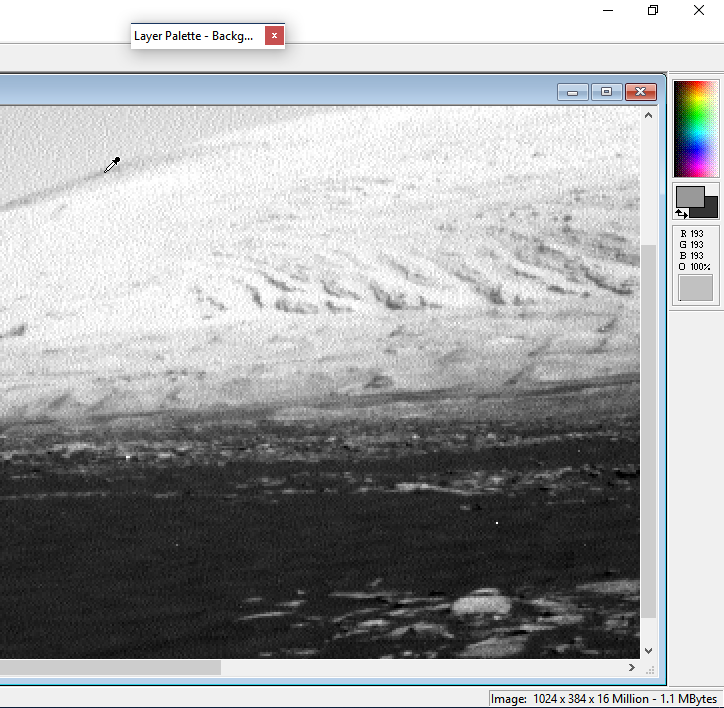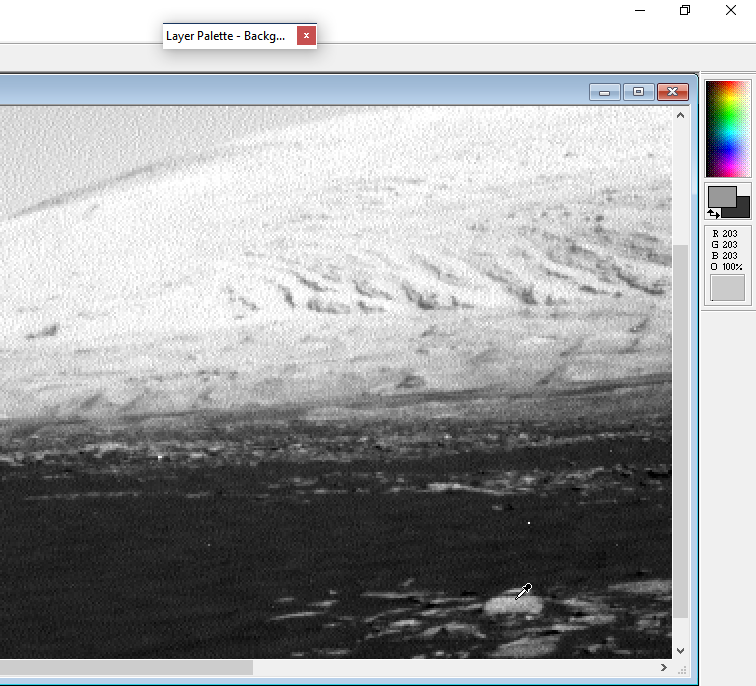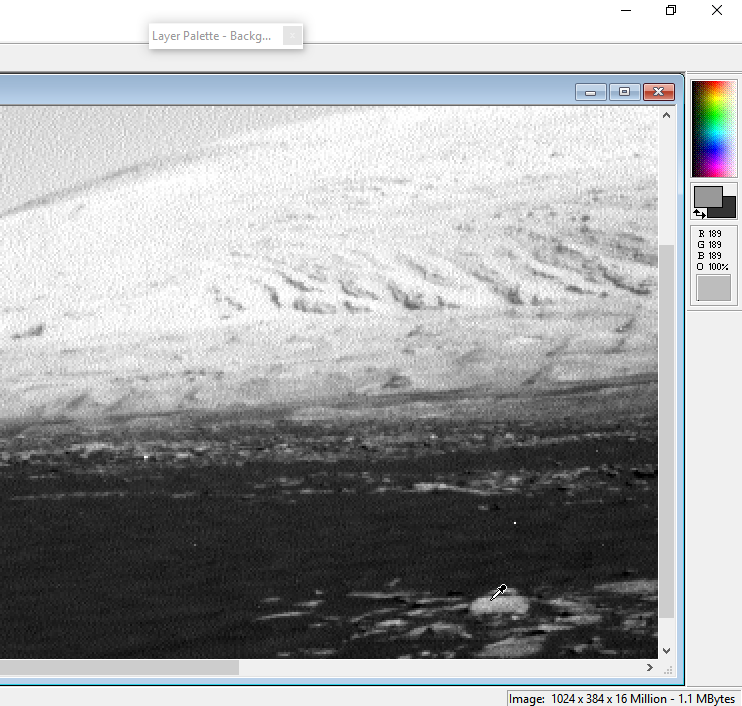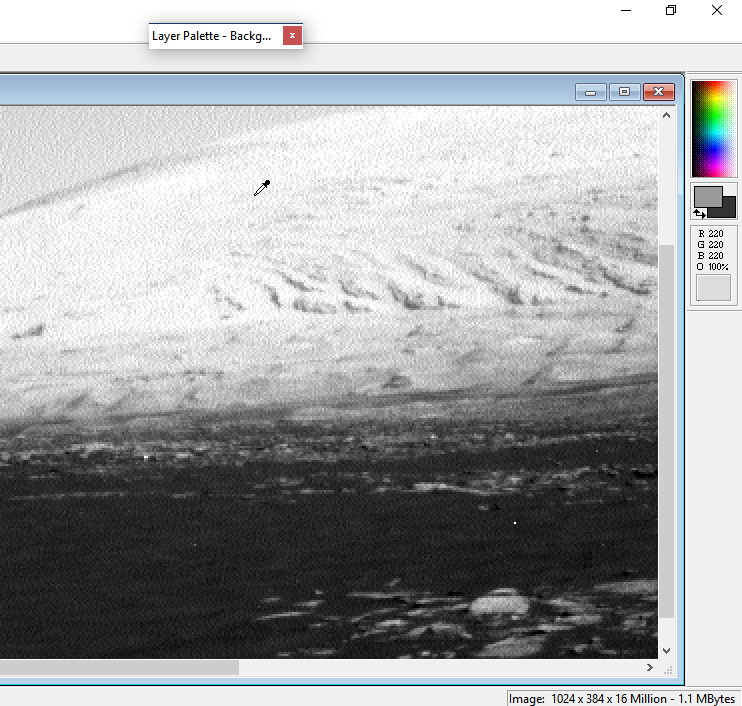It looks like you're using an Ad Blocker.
Please white-list or disable AboveTopSecret.com in your ad-blocking tool.
Thank you.
Some features of ATS will be disabled while you continue to use an ad-blocker.
share:
It does not work that way. I can take a picture of my solid red shirt and it will have a wide range of pixel values.
originally posted by: ArMaP
originally posted by: LookingAtMars
Really, I never noticed that. Maybe so, do you have some images that show that.
Sure.
I used a very old copy of PaintShopPro I have, as it shows the colour of the pixel under the cursor, so it's easier to see.
Hovering the cursor over the darker area of the mount I got values around 193 and 182.
When moving the cursor over that brighter rock near the bottom of the photo I got values around 189 and 203, which means that the rock is only slightly brighter than that dark area on the mount slope.
The mount itself is much brighter, with values around 220 (I chose one of the darkest pixels on that area).
originally posted by: ArMaP
originally posted by: LookingAtMars
Only NASA has the knowledge of how to land a craft safely on Mars (or even orbit Mars).
Mars Express has been orbiting and photographing Mars for almost 15 years without any problems.
I think you know NASA was involved in that project. Germany built the camera I think and a few other instruments were built by other countries. If you did some research you would find out that the hardware and knowledge that got it to orbit was supplied by NASA. England did Beagle II that hitched a ride, how did that work out?
edit on 10-9-2018 by LookingAtMars because: (no reason given)
a reply to: LookingAtMars
Looking at the difference between the maximum and the minimum I'm sure the temperature doesn't stay above 0º for a long time. As for the pressure, look at that chart I linked to above, if I'm not wrong it shows that at the air pressure present on Mars doesn't make a real difference to the freezing/melting point.
Looking at the difference between the maximum and the minimum I'm sure the temperature doesn't stay above 0º for a long time. As for the pressure, look at that chart I linked to above, if I'm not wrong it shows that at the air pressure present on Mars doesn't make a real difference to the freezing/melting point.
originally posted by: ArMaP
originally posted by: LookingAtMars
Sorry I missed these images. It was taken the same day as which image in the OP, the Pancam?
The one in the link is a mosaic made with photos taken on sol 387, the other photo is from the same day/sol as the one in the OP.
The images of yours below sure seem to show, what looks like, ice or snow. It is not just the processing, I can see it in the original image.
I suppose we have very different interpretations of how ice would look on a place like that, as I see nothing that looks like ice to me.
Really, you can not see how "white" the crater wall looks (considering it is Mars) . Looks like every mountain I have seen with snow on it, if it was on Mars.
originally posted by: ArMaP
a reply to: LookingAtMars
Looking at the difference between the maximum and the minimum I'm sure the temperature doesn't stay above 0º for a long time. As for the pressure, look at that chart I linked to above, if I'm not wrong it shows that at the air pressure present on Mars doesn't make a real difference to the freezing/melting point.
I did not say pressure, I said air density. Not as much heat transfer with low density air.
edit on 10-9-2018 by LookingAtMars because: (no reason given)
originally posted by: LookingAtMars
It does not work that way. I can take a picture of my solid red shirt and it will have a wide range of pixel values.
That's why I used more than one pixel, to get an average of the value of the pixels in those areas, although I only posted two photos for the dark patch on Mount Sharp and another two for the rock.
Maybe if I take the big rock and put it on the mount slope and take part of the mount slope and paste near the rock you are able to really see things as they are.

It's a crude cut and paste job, but it shows that the rock is much darker than the mount slope. If you don't believe it do it yourself with any image editing software (you don't need any special software, even Windows paint can do it).
originally posted by: LookingAtMars
If you did some research you would find out the the hardware and knowledge that got it to orbit was supplied by NASA.
Could you provide some real evidence instead of just words? That would help.
Thanks in advance.

originally posted by: LookingAtMars
Really, you can not see how "white" the crater wall looks (considering it is Mars) .
No, I don't see it as "white".
Looks like every mountain I have seen with snow on it, if it was on Mars.
None of the photos I have seen of mountains with snow (I have never seen snow with my own eyes) look like that to me.
originally posted by: LookingAtMars
I did not say pressure, I said air density. Not as much heat transfer with low density air.
What about the heat transfer of the ground?
a reply to: ArMaP
Talk to any Image expert and they will tell you there are too many variables. It would have to be controlled lighting for that to work. If you picked up a rock and put it on the side of the mount then took the picture it would kinda work, maybe.
But I will agree the rocks very well could be darker than the mount. I am more interested in what could be the remains of a glacier.
Talk to any Image expert and they will tell you there are too many variables. It would have to be controlled lighting for that to work. If you picked up a rock and put it on the side of the mount then took the picture it would kinda work, maybe.
But I will agree the rocks very well could be darker than the mount. I am more interested in what could be the remains of a glacier.
a reply to: ArMaP
No, because I already know. If you really support truth though, you will go find out, if the subject really interest you.
ETA: I will give you some where to start though. Compare MEX to MRO.
Could you provide some real evidence instead of just words? That would help.
No, because I already know. If you really support truth though, you will go find out, if the subject really interest you.
ETA: I will give you some where to start though. Compare MEX to MRO.
edit on 10-9-2018 by LookingAtMars because: (no reason given)
originally posted by: ArMaP
originally posted by: LookingAtMars
I did not say pressure, I said air density. Not as much heat transfer with low density air.
What about the heat transfer of the ground?
Yes, because the ground is very cold, it would contribute to the ice not "melting" very much. You have already agreed the ice would not melt that much, so why are we still going on about this?
This just looks so much like the remains of a glacier it is hard for me not to think it is. I am open to evidence it is something else or proof it
could not be. We have gone on for 5 pages and I have not seen anything to change my mind. You look at it as not being a glacier and need proof it is.
We will just have to agree to disagree.


edit on 10-9-2018 by LookingAtMars because: (no reason given)
originally posted by: ArMaP
originally posted by: LookingAtMars
It does not work that way. I can take a picture of my solid red shirt and it will have a wide range of pixel values.
That's why I used more than one pixel, to get an average of the value of the pixels in those areas, although I only posted two photos for the dark patch on Mount Sharp and another two for the rock.
Maybe if I take the big rock and put it on the mount slope and take part of the mount slope and paste near the rock you are able to really see things as they are.
It's a crude cut and paste job, but it shows that the rock is much darker than the mount slope. If you don't believe it do it yourself with any image editing software (you don't need any special software, even Windows paint can do it).
LOL, when I replied to this post the image had not loaded. By cutting ice from the mount and putting it on the ground. Then cutting a rock without ice on it and putting it on the mount with ice, proves the rocks on the ground are darker than the rocks on the mount? Yes they are because there is no ice on them and there is ice on the mount.
edit on 10-9-2018 by LookingAtMars because: (no reason given)
These navcams are tuned to red light wavelenghts. In the 600. 750nm range of the spectrum.
The redder something is, the more luminence will be presented in black and white photos. Red things should appear very white (in Black n white photos.)
The redder something is, the more luminence will be presented in black and white photos. Red things should appear very white (in Black n white photos.)
originally posted by: spacedoubt
These navcams are tuned to red light wavelenghts. In the 600. 750nm range of the spectrum.
The redder something is, the more luminence will be presented in black and white photos. Red things should appear very white (in Black n white photos.)
Red things? If I look at a pancam image, most things on Mars are red.
ETA: So now its not the mount is brighter, it is redder.
edit on 10-9-2018 by LookingAtMars because: (no reason given)
a reply to: LookingAtMars
Red, or more illuminated .
Or a shade of red close to the peak sensitivity of the camera. It would appear whiter, yes.
Most things are red yes, but not all the same shade or illumination.
Had you considered the tuning of the camera in your analysis?
Red, or more illuminated .
Or a shade of red close to the peak sensitivity of the camera. It would appear whiter, yes.
Most things are red yes, but not all the same shade or illumination.
Had you considered the tuning of the camera in your analysis?
a reply to: spacedoubt
I just found it strange because I had seen a lot of navcam images and never saw Mount Sharp that white. Could be ice. Wasn't there a press release a while back about ice at a peak on the crater rim? It would not be ground breaking news to have some ice on Mars.
I just found it strange because I had seen a lot of navcam images and never saw Mount Sharp that white. Could be ice. Wasn't there a press release a while back about ice at a peak on the crater rim? It would not be ground breaking news to have some ice on Mars.
a reply to: LookingAtMars
I’m not convinced water-ice could survive on the surface though.
If you remember the Phoenix lander data, the images showed water ice just below the surface in a couple of ways. One was chunks that were exposed by lander’s robotic arm. They sublimated fairly soon after exposure.
The other was under the lander, where it looked at if the landing thrusters had disturbed the soil so much that some ice reverted to liquid long enough to redeposit on the landing gear, like frozen droplets.
Which also eventually sublimated away.
So I think like others there is a lot of water, but it doesn’t last long when exposed.
But I do like the nav cam photos, the long range photos are very Ansel Adams. Who was also a fan of
Red filters in his black and white landscapes.
I’m not convinced water-ice could survive on the surface though.
If you remember the Phoenix lander data, the images showed water ice just below the surface in a couple of ways. One was chunks that were exposed by lander’s robotic arm. They sublimated fairly soon after exposure.
The other was under the lander, where it looked at if the landing thrusters had disturbed the soil so much that some ice reverted to liquid long enough to redeposit on the landing gear, like frozen droplets.
Which also eventually sublimated away.
So I think like others there is a lot of water, but it doesn’t last long when exposed.
But I do like the nav cam photos, the long range photos are very Ansel Adams. Who was also a fan of
Red filters in his black and white landscapes.
originally posted by: LookingAtMars
No, because I already know. If you really support truth though, you will go find out, if the subject really interest you.
I'm not interested in spending time to try to confirm an unsupported claim by someone on the Internet, I am one of those people that think those that make the claims are the ones that should provide the information in which they base them.
ETA: I will give you some where to start though. Compare MEX to MRO.
I don't like charades.
new topics
-
USO 10 miles west of caladesi island, Clearwater beach Florida
Aliens and UFOs: 3 hours ago -
Abortions in first 12 weeks should be legalised in Germany, commission says
Medical Issues & Conspiracies: 11 hours ago
top topics
-
Anti-Israel Protesters in CHICAGO Chant 'Death to Israel and 'Death to America'
Social Issues and Civil Unrest: 15 hours ago, 15 flags -
Denver to Defund the Police 8.4 Million To Pay for Illegal Aliens
Social Issues and Civil Unrest: 17 hours ago, 14 flags -
Running Through Idiot Protestors Who Block The Road
Rant: 13 hours ago, 12 flags -
Fossils in Greece Suggest Human Ancestors Evolved in Europe, Not Africa
Origins and Creationism: 17 hours ago, 9 flags -
Report March 2024 - Underwater UFOs display capability that ‘jeopardizes US maritime security,’
Aliens and UFOs: 17 hours ago, 6 flags -
Tesla cutting 14,000 jobs
Global Meltdown: 12 hours ago, 6 flags -
USO 10 miles west of caladesi island, Clearwater beach Florida
Aliens and UFOs: 3 hours ago, 6 flags -
Israel ufo shoot down drones?
Aliens and UFOs: 12 hours ago, 5 flags -
Abortions in first 12 weeks should be legalised in Germany, commission says
Medical Issues & Conspiracies: 11 hours ago, 5 flags -
On this Day in History, April 15, 1865, Abraham Lincoln Passed Away.
General Chit Chat: 12 hours ago, 4 flags
active topics
-
Mandela Effect - It Happened to Me!
The Gray Area • 97 • : inflaymes69 -
Abortions in first 12 weeks should be legalised in Germany, commission says
Medical Issues & Conspiracies • 9 • : Vermilion -
Running Through Idiot Protestors Who Block The Road
Rant • 45 • : glen200376 -
The Reality of the Laser
Military Projects • 27 • : Zaphod58 -
Israel ufo shoot down drones?
Aliens and UFOs • 17 • : Zaphod58 -
Tesla cutting 14,000 jobs
Global Meltdown • 43 • : Vermilion -
USO 10 miles west of caladesi island, Clearwater beach Florida
Aliens and UFOs • 6 • : matafuchs -
-@TH3WH17ERABB17- -Q- ---TIME TO SHOW THE WORLD--- -Part- --44--
Dissecting Disinformation • 471 • : 777Vader -
Woke Leftist dems, hate Your Rights and the Country;
Political Issues • 62 • : ashisnotanidiot -
It has begun... Iran begins attack on Israel, launches tons of drones towards the country
World War Three • 625 • : Justoneman





